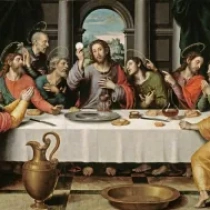 renaissance - high
renaissance - high
Description Vicente Juan (Juan de Juanes) Macip
Vicente Juan Macip, better known as Juan de Juanes, emerged as a prominent figure in the Spanish Renaissance, born around 1510 in La Font de la Figuera. His artistic journey unfolded against the backdrop of a burgeoning cultural and religious fervor that defined 16th-century Spain.
Juanes hailed from a family of artists, and his early training under his father, Vicente Macip, laid the foundation for his artistic prowess. His relocation to Valencia marked a pivotal moment in his career, exposing him to the vibrant artistic community that thrived in the city.
The artistic milieu of Valencia, influenced by the Italian Renaissance, provided fertile ground for Juanes to merge classical ideals with a devout religious sensibility. His paintings, often infused with a luminous palette and meticulous attention to detail, epitomized the Spanish Renaissance style.
Juanes' commitment to religious themes aligned with the fervent Catholicism of the era. His works, such as "The Last Supper" and "The Crucifixion," demonstrated a profound engagement with Christian narratives, capturing the spiritual essence of the subjects.
One of Juanes' notable contributions was his role in introducing Italian Renaissance principles to Spanish art. The influence of Raphael, in particular, is evident in Juanes' compositions, marked by harmonious proportions and a serene beauty that resonates through his religious scenes.
Beyond his religious paintings, Juanes was recognized for his portraiture. His ability to capture the individuality of his subjects, often adorned with rich fabrics and intricate details, showcased his versatility as an artist.
Juanes' career reached its zenith with commissions from influential patrons, including the Spanish royal family. His role in decorating the Monastery of San Miguel de los Reyes and his collaborations with the renowned sculptor Juan de Juni solidified his status as a key figure in Spanish Renaissance art.
Despite the tumultuous political and religious climate of his time, Juanes navigated his career with finesse, maintaining a delicate balance between his devout Catholicism and the artistic innovations of the Renaissance. His legacy endured through his sons, who continued the family's artistic tradition.
Juan de Juanes passed away around 1579, leaving behind a legacy that reverberates through the corridors of Spanish art history. His ability to harmonize classical ideals with religious devotion, coupled with his influence on subsequent generations of Spanish painters, secured his place as a luminary of the Spanish Renaissance. Juanes' canvases remain windows into a world where faith and art converged in a captivating dance of color, form, and spirituality.




No Comments Yet...